BENJAMIN HUNT
OPERATING UNDER THE INFLUENCE


OPERATING UNDER THE INFLUENCE

Ben Hunt – Operating Under the Influence, represents a chance to view his astounding work. A few years ago, an artist colleague of mine, Mark Emerson, sent me some images of Ben Hunt’s work and thought I might enjoy seeing them, he was right. I marveled at how well the work was constructed, intrigued at how he was using casting and really enjoyed the narrative of the work.
Hunt was a transplant to the Sacramento area. His move gave him a new place to look for inspiration and he found it not only in nature, but also in agricultural and local industry. This connection between nature and industry is prevalent and easily witnessed throughout his work. This exhibition combines those elements with Hunt’s journey into his own past. This leads the viewer on a wonderful journey of discovery.
I was not the only one to witness the journey into Hunt’s artwork. My colleague, Mirabel Wigon, had also seen his work and recommended that we develop an exhibition of Hunt’s work here at the University Art Gallery. The UAG helps to support our faculty’s teaching and it is through faculty recommendations that many exhibitions come to our galleries. Many thanks to Mirabel for recommending such a talented artist.
I would also like to thank the many colleagues that have been instrumental in presenting this exhibition. Ben Hunt for the chance of exhibiting work, Kelly Linder for the wonderful catalog essay, Brad Peatross of the School of the Arts, California State University, Stanislaus for the catalog design and Parks Printing for the printing this catalog.
I would also like to extend many thanks to the Instructionally Related Activates Program of California State University, Stanislaus, as well as anonymous donors for the funding of the exhibition and catalogue. Their support is greatly appreciated.
 Dean De Cocker, Director, University Art Gallery California State University, Stanislaus
Dean De Cocker, Director, University Art Gallery California State University, Stanislaus
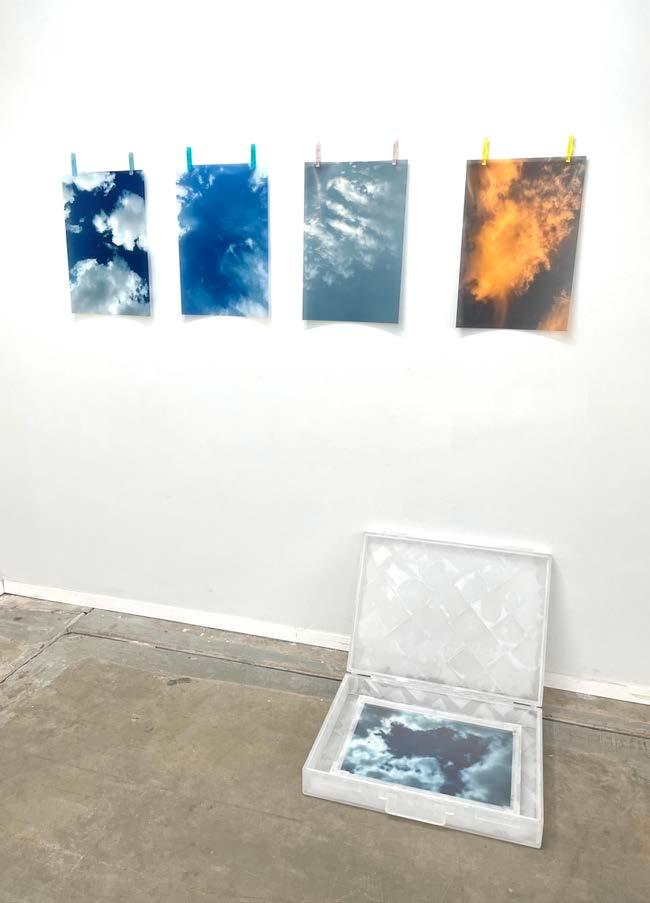 Untitled (SKY ), acrylic, resin and archival ink on film, variable size, 2022
Untitled (SKY ), acrylic, resin and archival ink on film, variable size, 2022
“I don’t remember my dreams too much. I hardly have ever gotten ideas from nighttime dreams. But I love daydreaming and dream logic and the way dreams go.” –David Lynch
Limitless images and objects influence our navigational decision-making through a contemporary world that seems, at times, to be a synthetic and fabricated topography. The vast amount of information that we engage in and process daily amazes and confounds me. Moreover, in art-making, how does one square the making of images and objects in a world already full of objects and images?
As a collector and maker of “things”, it is a question that I ask myself frequently. The materials that I use are primarily reclaimed or recycled and much of it is man-made, such as acrylic, aluminum and resin. I am drawn to these materials as they create tension within the work that flutters between realism and surrealism.
Since moving to Sacramento, I have been inspired by the city’s urban forests and the Central Valley region’s agricultural and industrial areas. It is fertile ground for exploration. I am very interested in our relationship with nature. My work is a response to the harmonious connection between the space we occupy in the manufactured world and the spontaneous organic patterns derived from light and space. Creating works that draw a connection between natural and industrial forms has been a reoccurring theme in my artmaking for over twenty-five years.
I am drawn to objects lost, discarded or have been left to collect dust due to obsolescence. Solitary “things” have inherent meaning, but when connected to another object, or placed in juxtaposition with another “thing” or group of “things”, the meaning changes and creates visual sentences, stories or poetry. If I find an object, like an old bottle or light bulb that has some interesting characteristic, I will dip the object in a thin layer of wax to soften its detail and remove it from the original form. Then I will make a plaster or silicone mold of the object and reproduce it in either resin or wax (that will eventually become cast aluminum or bronze). Over time, I have developed a small mold library that I can pull images from to create sculptural compositions. Often times, I will compose these objects within a fabricated aluminum or acrylic framework that resembles furniture and utilitarian objects. I liken it to the “Cut-up Method” technique of writing contributed to the Dadaists in the 1920’s and popularized by William Burroughs in the 50’s and 60’s. I found it to be a way to free associate on a formal visual level and create new narratives through sometimes very disparate and conflicting images. The artwork and objects that I create are based on the intersection between utilitarian items, nature and my interest in reflections of the past through reproduced family photographs.



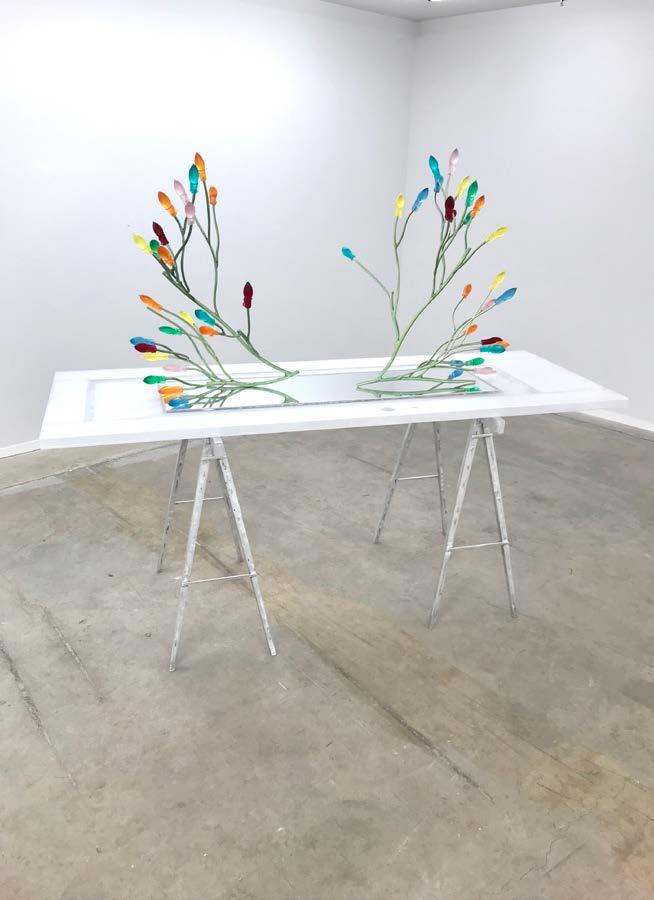

 Taking a Piss Out of a Corner, acrylic, resin and aluminum, variable sizes, 2018
Taking a Piss Out of a Corner, acrylic, resin and aluminum, variable sizes, 2018



 Grafts, cast and fabricated aluminum, 32” x 20” x 20”, 2022
Grafts, cast and fabricated aluminum, 32” x 20” x 20”, 2022

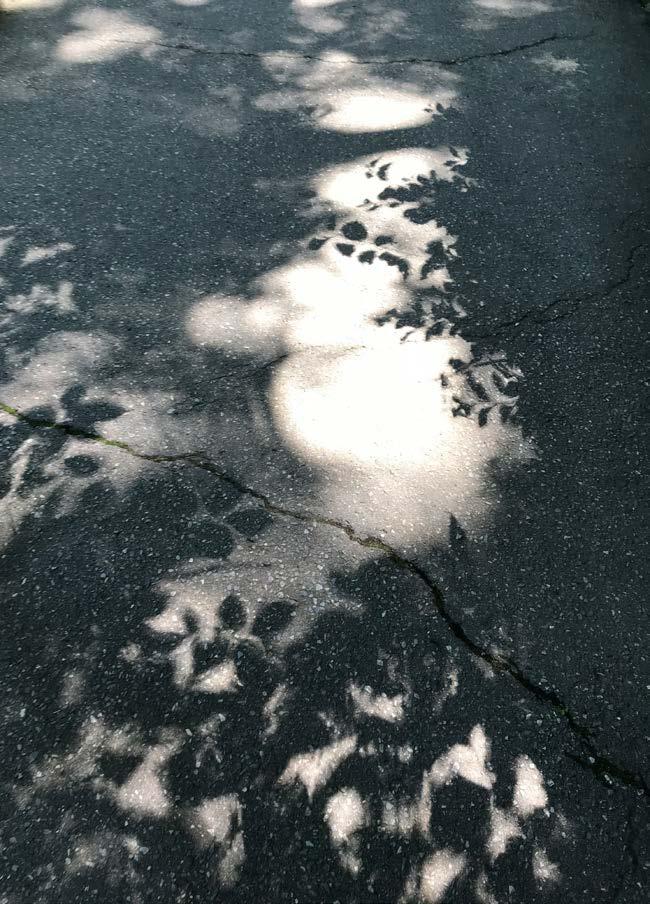
A simple photo on a bedside table, sea shells in a bowl of keys, family photos stuck to the face of a refrigerator, Post-it notes on the steering wheel, an old photo booth strip used as a book mark, or an image of a day at the beach used as a screen saver. Referencing periods and moments of time in life is an uncontrollable preoccupation that seems to be a constant in the normal operations of my daily life. I assume that I am not the only one with the specters of family history that influence everyday life decision-making, no matter how serious or mundane. It’s an assumption made due to the reality that most households, places of business and prayer take careful consideration in how photographs are placed in relation to the architecture and surrounding furniture. Mantles, sideboards, bookshelves and credenzas become secular altars to pinpoint moments in time.
The Grey Area is a body of work that integrates mined family photographs contained within acrylic sculptures of furniture and picture frames. The images are superimposed one in front of the other. My interest centers on the liminal space between the layered photographs and how they are set upon or within fabricated furniture-like sculptures that evoke a sense of history and nostalgia. The resulting works take into question the fragile and seemingly deceptive nature of photographic memory and recollection.

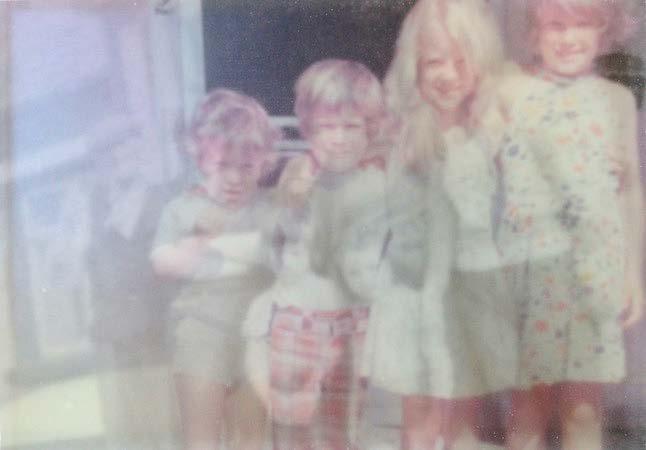


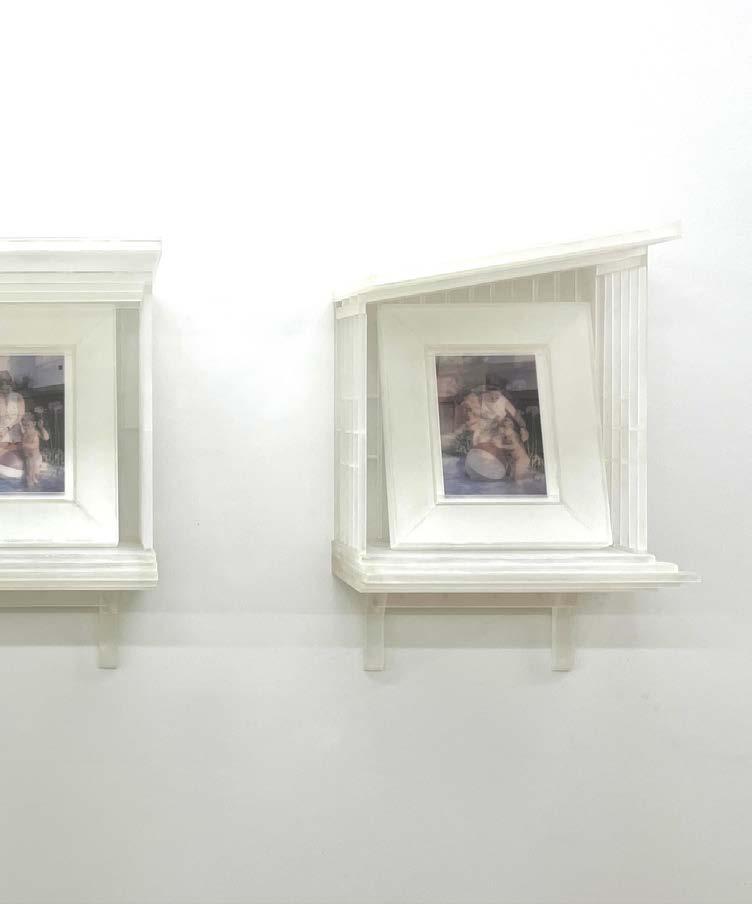 The Swim Lesson, acrylic and embedded photo, 30” x 60” x 12”, 2011
The Swim Lesson, acrylic and embedded photo, 30” x 60” x 12”, 2011


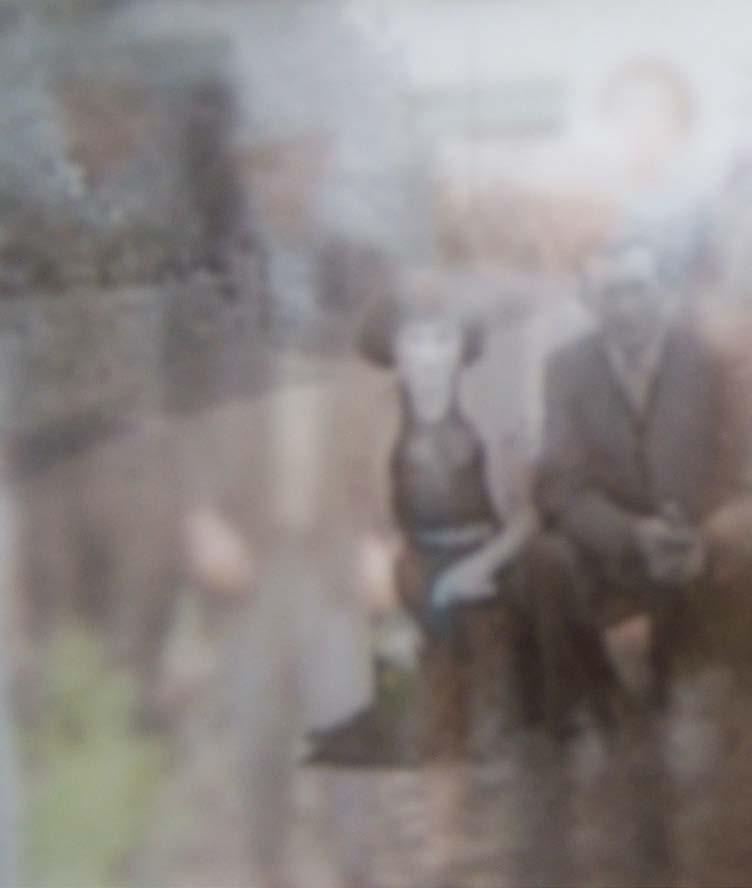
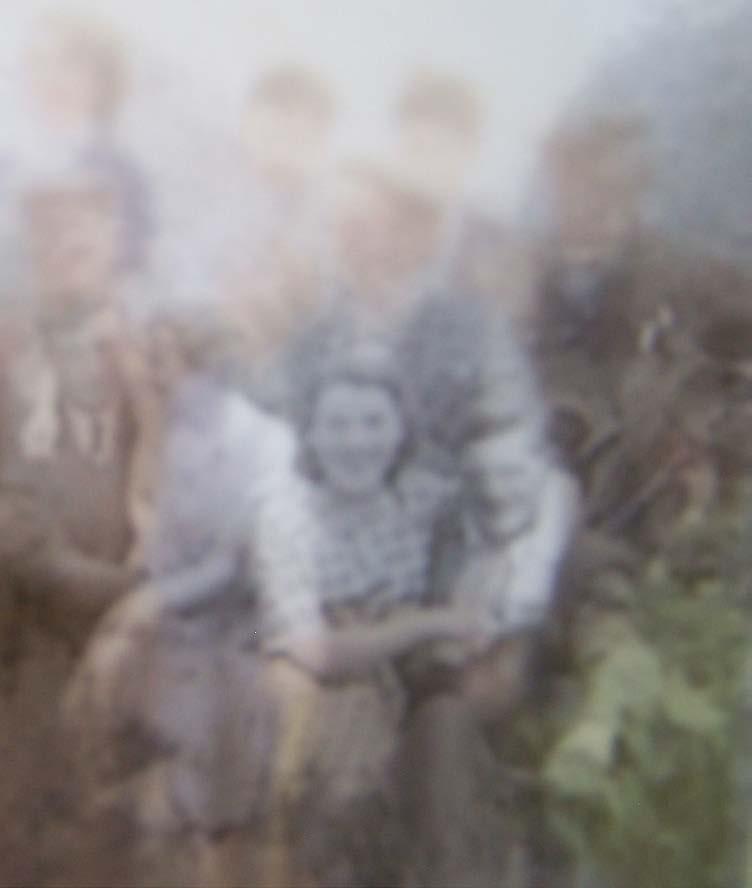 Figment 3, acrylic with embedded photo, 7 ½” x 9 ½” x 1”, 2008
Figment 3, acrylic with embedded photo, 7 ½” x 9 ½” x 1”, 2008


Ben Hunt is a virtuoso of materiality. Blurring boundaries between the real, the remembered, and the imaginary, his sculptures and photographic works appear as familiar objects and “things”, yet they are wholly something new. The recognizable individual elements are the focal point that draw the viewer in. There is a credenza. There is a ladder, a bottle, a chair, a dolly, a tree branch, a suitcase. In their ordinariness we are led into believing what we see is what we know. Yet…
The Ladder
Hunt’s sculptures are familiar through their replication and repetition of everyday objects. French philosopher Jacques Derrida posited that repetition and difference are related if not reliant on one another. While difference implies divergence and decentering, repetition is associated with displacement and disguising. In tandem, repetition and difference create a generative space of possibility. It is in this liminal space that Hunt displaces the familiar with the unfamiliar. Fabricating objects through recycled and repurposed materials and displaying them in such a way that the individual elements generate new associations, Hunt points the viewer towards the subtle shifts in difference.
In the piece Winter Reveal, a ladder is no longer a utilitarian object, nor is the bottle on the lower step or the container just above. The branches, stripped of their leaves and set atop the ladder, resemble nature, but not fully. Exacting in form, the ladder is fabricated from translucent acrylic while the additional elements from cast aluminum. In their sequencing, Hunt first undermines the familiarity through the shift in materiality then pushes the work towards the uncanny in his assembly of the various elements. In his essay The Uncanny (1919), Sigmund Freud defined the idea as the instance when something can be familiar and yet alien at the same time. Even as the individual objects resemble their everyday counterparts, the sculptural forms deny their illusion. The bottle placed on the bottom step seems intentionally casual. The ladder itself has an otherworldly presence. Yet it is the bare branches emerging from the top rung with the fragments of a toy caught in its upper limbs that give pause. It’s as if the sculpture is a moment of suspended time, playing out in a dream.
Hunt explores these types of uncanny moments throughout his work. Sideboard (2014), also fabricated from acrylic, appears as a ghostly facsimile of a piece of furniture. Placed on the sideboard’s surface are a series of framed photographs that are familiar through their arrayed display. Here Hunt introduces found family photographs, albeit layering images to create a blurred subject. This out of focus perspective permeates the entire piece. The face of the sideboard recalls simulated wood grain and cabinetry hardware, still the details are elusive. Like trying to remember the particulars of a dream or a distant memory, the various elements in the work are both present and absent.
Memory plays an important role in Hunt’s work. Only memory allows the mind to retain the past, however imperfectly, with reference to the reality of the present. Carefully choreographing the various components through his material choices in each sculpture, Hunt evinces how the mind, when it relies on memory, engenders change and loss even as it accumulates, filters, and distorts.
The Valise
Nature is a recurring motif in Hunt’s work. Clouds and sky, treetops and sky, tree trunks and branches appear in various forms.
Untitled (Sky) is a series of photographs printed on transparency film. Like the acrylic sculptures, the translucency of the film, hung just off the wall with cast acrylic clothes pins, gives the objects an otherworldly appearance even as we recognize an ordinary sky
framed by changing clouds. Paired with the photographs is an open acrylic suitcase with a detailed handle and lock. In this suitcase sits another of the photographs—a box for memories, a container for remembering. In 1935 Marcel Duchamp began a limited edition of valises all containing small replicas and reproductions of his most important works to date, along with one hand-colored “original” affixed to the inside of the lid. Titled La Boite-en-Valise (Box in a Suitcase), Duchamp described the piece as a “portable museum.” Hunt’s suitcase serves a similar purpose, not as a celebration of his artistic endeavors, but as an homage to nature. Will our memories of nature outlast the impact of humans on this earth? Can we ever capture the beauty, the tranquility, the inspiration that nature affords our daily lives?
In his sculpture, Hunt deftly juxtaposes nature with the industrial, creating tension between his choice of materials, his fabrication process, and the subject of the work. Hunt’s is often an unnatural nature, constructed from recycled and repurposed materials that are distinctly man-made. The photographs of clouds and sky in Untitled (Sky) and trees and sky in the triptych Oculus offer a softer approach tinged with nostalgia. Nature is presented as memory—real and imagined.
To take a photograph is often described as capturing a moment. In her 1973 essay On Plato’s Cave, Susan Sontag described photography this way: “All photographs are memento mori. To take a photograph is to participate in another person’s (or thing’s) mortality, vulnerability, mutability. Precisely by slicing out this moment and freezing it, all photographs testify to time’s relentless melt.” In his Grey Area series, Hunt mines family photos embedding images within fabricated acrylic frames. Layering and merging successive photos into a single image, the artist plays with time, extending the image beyond a singular moment. In Homewood, a young couple poses on the sidewalk in front of their house. One image shows the couple closer together, the woman’s arm draped inside her husband’s. The second image shows the couple farther apart, the woman’s hands now clasped in front of her. But it is impossible to know which moment came first. In this work, Hunt literally “melts” time and the superimposed images become a singular moment. Homewood and similar works propose that a photograph can reveal the deceptiveness of recollection while also regenerating a memory preserved by an image.
As an artist working post-Dada, post-Surrealism, post-Conceptualism, post-Minimalism, one can only imagine the artistic influences that can percolate into new ideas. And so, it is true for Ben Hunt. Graft incorporates an ordinary stool form into a restrained composition of three elements. However, it would be remiss to think a stool is just a stool in the hands of a craftsman who can recreate an object in a new material, which somehow retains the essence of its objecthood while also generating newfound associations. The stool may or may not reference Marcel Duchamp’s Bicycle Wheel. Or the stool may or may not allude to the numerous seats occupied by students in the sculpture lab where the artist works. Or is the stool from the artist’s own studio? Like Bicycle Wheel, an unexpected object sits atop the stool—here it is a defoliated branch pinched at the ends with clothes pins. It is both quirky and unsettling, a nod back to Surrealist and Dada concepts. And still, the stool remains a stool.
Once again, Hunt deftly balances form and materiality with subtle juxtapositions that lead to contextual references. However, the sculpture never strays far from an object’s true representation—they are contingent objects.
Kelly Lindner is the Art Galleries and Collections Curator for the University Galleries at Sacramento State.
Ben Hunt is a visual artist and “fabricator”. Born and raised in San Diego, CA., he received his Master of Fine Arts degree, in Spatial Art, from San José State University in 2008. He has exhibited both regionally and nationally and has taught sculpture at both Idaho State University in Pocatello, Idaho and California State University, Sacramento. In 2008, Ben was invited to be the Visiting Artist and Guest Lecturer in Sculpture at Idaho State University and was the recipient of the International Sculpture Centers award for Outstanding Student Achievement in Contemporary Sculpture. In 2011, he joined the Art Department faculty at CSU Sacramento as an adjunct studio lecturer in Sculpture and concurrently worked as a preparator at the Crocker Art Museum. In 2015 Ben was awarded the Leff-Davis Fund for Visual Artists by the Sacramento Region Community Foundation. At present, Ben is a technical staff member in the Art Department at CSUS and is an active member of AXIS gallery. He lives and maintains a studio practice in Sacramento, California.
2008 Master of Fine Arts, Spatial Art, San José State University
2000 Bachelor of Fine Arts, Spatial Art, San José State University
2017– Instructional Support Technician, California State University, Sacramento, CA
2011–17 Adjunct professor, Lecturer, Sculpture, California State University, Sacramento, CA
2008-09 Visiting Artist and Guest Lecturer, Idaho State University, Pocatello, ID
SELECT SOLO EXHIBITIONS
2022 Lost at Home, Found in Garden, Axis Gallery, Sacramento, CA
2021 Operating Under the Influence, Axis Gallery, Sacramento, CA The Ceiling, Floor and a Television Sky, Axis Gallery, Sacramento, CA
2018 Surveying the Prairie of a Room, Axis Gallery, Sacramento, CA
2016 Fragmented Narrative, Shi Mo Center for the Arts, Sacramento, CA
2012 Home Works, Robert T, Matsui Gallery, Sacramento City Hall, Sacramento CA,
2009 Benjamin Hunt: Current Work, Gate City Fine Art Gallery, Pocatello ID
2008 Reclamation, Reconstructions and Other Grey Areas, Idaho State University, Pocatello ID
SELECT GROUP EXHIBITIONS
2020 Ben Hunt / Richard Gilles, AXIS gallery, Sacramento CA
Jiayi Young / Benjamin Hunt, Virtual exhibition, AXIS gallery, Sacramento CA
2019 The Gun Show, Gallery 1616, Sacramento, CA
Axis Exchange: GearBox Gallery, Oakland CA
2018 Still Life: Ben Hunt / Nick Shepard, AXIS gallery, Sacramento CA
2017 #Resist, Axis Gallery, Sacramento, CA
Under Construction – Ben Hunt, Nick Shepard, Bill Mead, Axis Gallery, Sacramento, CA
Anne & Mark’s Art Party, Santa Clara Fair Ground Exposition, San Jose, CA
2016 Dual-Duel, Ben Hunt and Bryan Valenzuela, Blue Line Arts, Roseville, CA
Left Coast Annual Juried Exhibition, Sanchez Art Center, Pacifica CA
The People Next Door, Art Arc Gallery, San Jose CA
2014 A Vision for Broadway, Robert Matsui Gallery in Sacramento City Hall, Memory Pore, Axis Gallery, Sacramento CA
2012 Linear & Non-Linear Possibilities, Gallery 1075, West Sacramento CA
2011 Wood, Tangent Gallery, Sacramento CA
2009 Idaho State University Art Faculty Show, John B, Davis, Gallery, Pocatello, ID
2008 Outstanding Student Achievement in Contemporary Sculpture Award Show, International Sculpture Center, Hamilton, NJ
2015 Leff-Davis Fund for Visual Artists, Sacramento Region Community Foundation,
2008 International Sculpture Center: Outstanding Student Achievement in Contemporary Sculpture Award
2008 Joan Mitchell Foundation 2008 MFA Grant Candidate, San José State University nominee
Crocker Art Museum, Sacramento, CA
Leff-Davis Collection, Hanover, NH
PRESS AND PRINT
2012 Home Sweet Home, Local sculptor depicts the elusive quality of memory, Debra Belt, Inside the City, July 2012, Pages 48-49 Inside Publications, 3104 O St, Sacramento, CA,
2008 Fragments, Frameworks and Foundations, Sally Sumida, Lift Off 2008, San José Sate University MFA Graduate Exhibition Catalogue, Copyright 2008 San José State University School of Art & Design with the Art History Association at SJSU
Artifacts of Family and Roots, Erin Goodwin-Guerrero, ArtShitft San Jose, Cultural Tectonics and View from the Fault Line
International Sculpture Center: 2008 Outsanding Student Achievement in Contemporary Sculpture, Sculpture Magazine, October 2008, Pg, 58, Vol, 27 No, 8
2014 Broadway Augment, Digital virtual sculpture, Commissioned by the Sacramento Metropolitan Arts Commission
2011 Cable Spool Wheel and Pallet Bike Rack Sculptures, R street corridor, Sacramento CA
Commissioning agency: Capitol Area Development Authority
2007 Time Capsules/Desk Chair Project, Camden Community Center –San José, CA
Dr. Ellen Junn, President
Dr. Kimberly Greer, Provost/Vice President of Academic Affairs
Dr. James A. Tuedio, Dean, College of the Arts, Humanities and Social Sciences
Martin Azevedo, Associate Professor, Chair
Tricia Cooper, Lecturer
Dean De Cocker, Professor
James Deitz, Lecturer
Daniel Edwards, Associate Professor
Jessica Gomula-Kruzic, Professor
Dr. Alice Heeren, Assistant Professor
Daniel Heskamp, Lecturer
Chad Hunter, Lecturer
Dr. Carmen Robbin, Professor
Ellen Roehne, Lecturer
Dr. Staci Scheiwiller, Associate Professor
Susan Stephenson, Associate Professor
Jake Weigel, Associate Professor
Mirabel Wigon, Assistant Professor
Alex Quinones Instructional Tech II
Kyle Rambatt, Equipment Technician II
Dean De Cocker, Director
Kory Twaddle, Gallery Assistant
Brad Peatross, Graphic Specialist II
Ben Hunt would like to acknowledge and thank Dean DeCocker and Mirabel Wigons for the invitation to exhibit at CSU Stanislaus, Mark Emerson for planting the seed. Kelly Lindner for contributing a very thoughtful essay, Nick Shepard (photo credit pgs. 8-11), Muzi Rowe (photo credit pgs 14-15, 22-23), AXIS Gallery, CSU Sacramento Art Department, Kevin Ptak, Jolie Roberts, Kate Wallace, Andrew Connelly, Robert Ortbal, and Mustafa Shaheen. Ben would also like to extend a great deal of gratitude to San José State University Art and Art History faculty members David Middlebrook, David Kimball Anderson, Linda Walsh and Shannon Wright for their guidance and mentorship, Emily Leff and James Davis for their continued support of his work, and Ellen Hunt for her patience, love and friendship.
